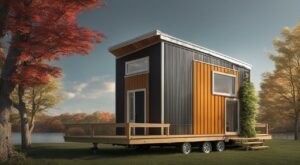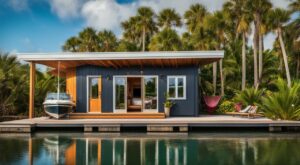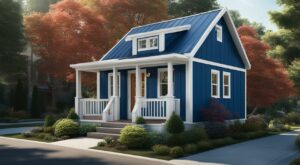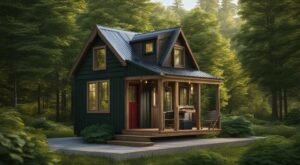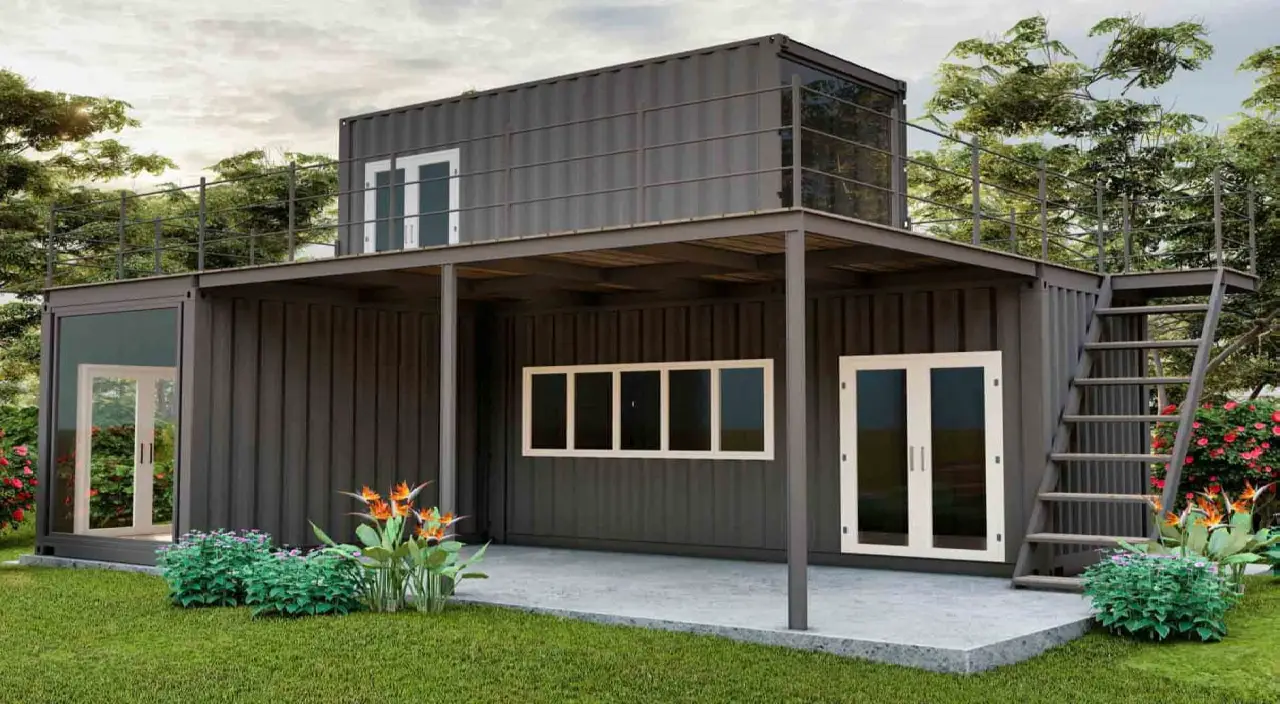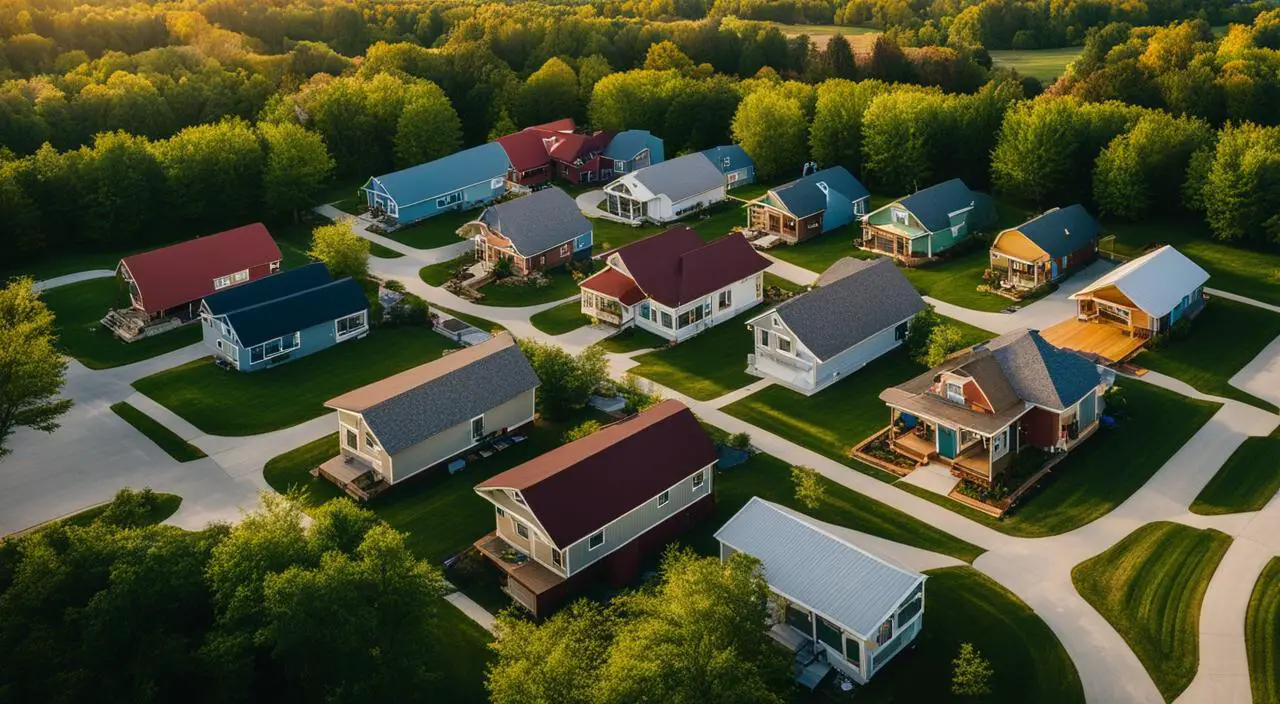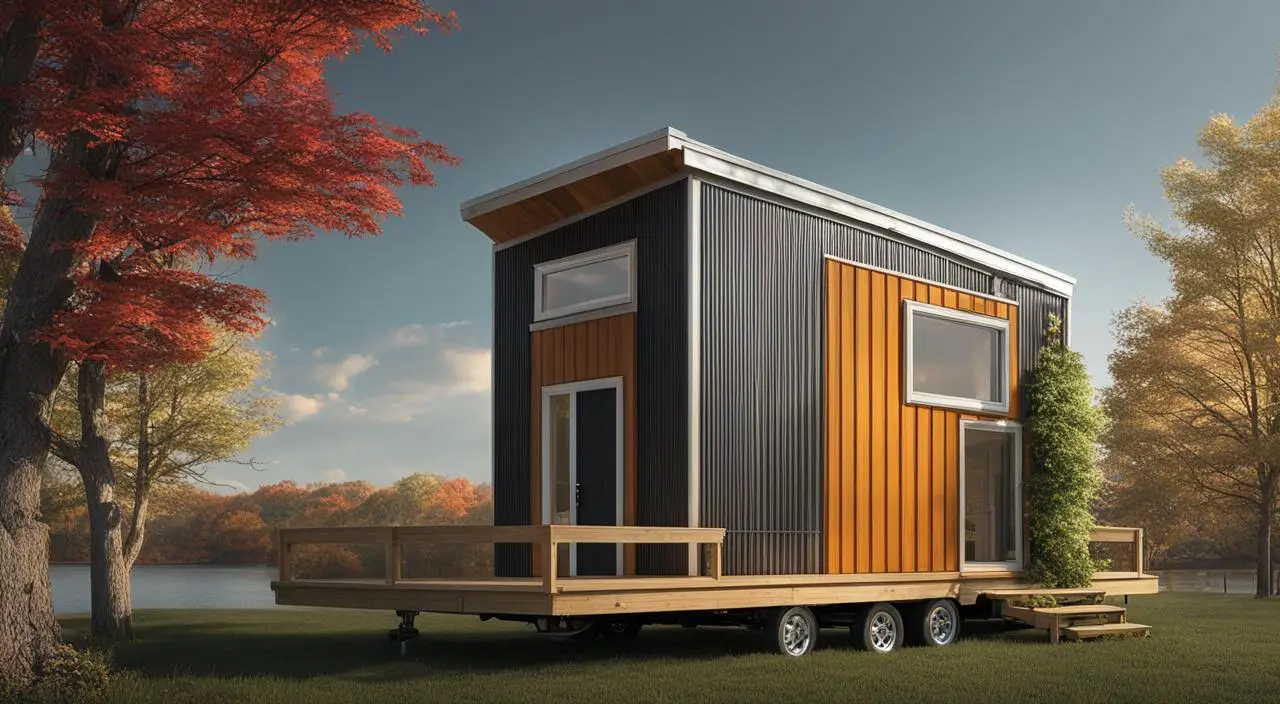Your cart is currently empty!
Tiny House Laws UK: A Comprehensive Guide
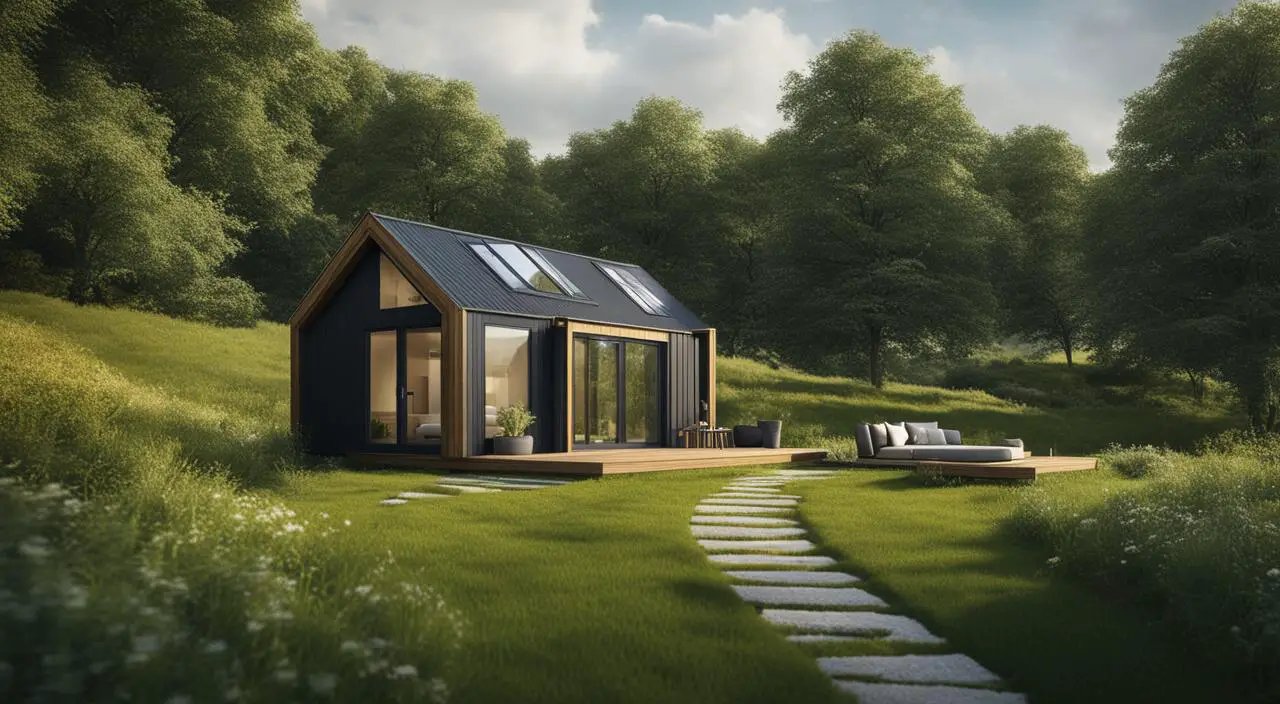
Affiliate Disclaimer: This post may contain affiliate link or links
Tiny house laws UK: Tiny houses have become a popular housing option for those who value simplicity, minimalism, and a smaller environmental footprint.
However, understanding the legal requirements and regulations surrounding tiny houses in the UK is crucial to ensure a successful journey into tiny house living.
Contents
Whether you are planning to build a tiny house on your own land or looking to purchase a pre-built tiny house, it is important to be aware of the necessary permits, planning permission, and zoning laws that may apply.
In this comprehensive guide, we explore the intricacies of tiny house laws in the UK, including the legislation, regulations, and legal requirements that apply to tiny house dwellings.
We also discuss the benefits of tiny house living, financial considerations, and regional differences in tiny house regulations, using case studies to illustrate these concepts.
Read on to learn more about tiny house laws in the UK and how they may impact your journey towards a simpler, more sustainable lifestyle.
Understanding Tiny Houses and the Tiny House Movement

The tiny house movement has gained momentum in recent years, as people seek to simplify their lifestyles and reduce their footprint.
The concept of tiny living involves downsizing to a much smaller living space, often under 400 square feet.
At the heart of the tiny house movement is the desire for a more sustainable, minimalist lifestyle. Many people feel overwhelmed by the idea of owning a large home and all the associated costs and maintenance.
By embracing tiny living, individuals can achieve financial freedom, spend more time on their passions and hobbies, and reduce their environmental impact.
Tiny houses can come in many forms, including mobile tiny homes and converted shipping containers.
While they may be small in size, they often offer all the necessary amenities for comfortable living, such as a kitchen, bathroom, and sleeping area.
Benefits of Tiny Living
There are many benefits to living in a tiny house, including:
- Lowered costs: Tiny houses are often much more affordable than traditional homes, both in terms of upfront costs and ongoing expenses.
- Reduced environmental impact: The small size of tiny houses means they require fewer resources to build and maintain, and they often use sustainable materials and energy-efficient design.
- Simple living: By downsizing to a smaller space, individuals can declutter and simplify their lives, allowing for more time and energy to focus on other passions and activities.
- Flexibility: Tiny houses can be built on wheels, allowing for easy mobility and the freedom to travel or move as needed.
Overall, the tiny house movement offers an alternative to the traditional housing market, allowing individuals to live more simply and sustainably while achieving financial freedom and flexibility.
Types of Tiny Houses and Alternative Housing Options
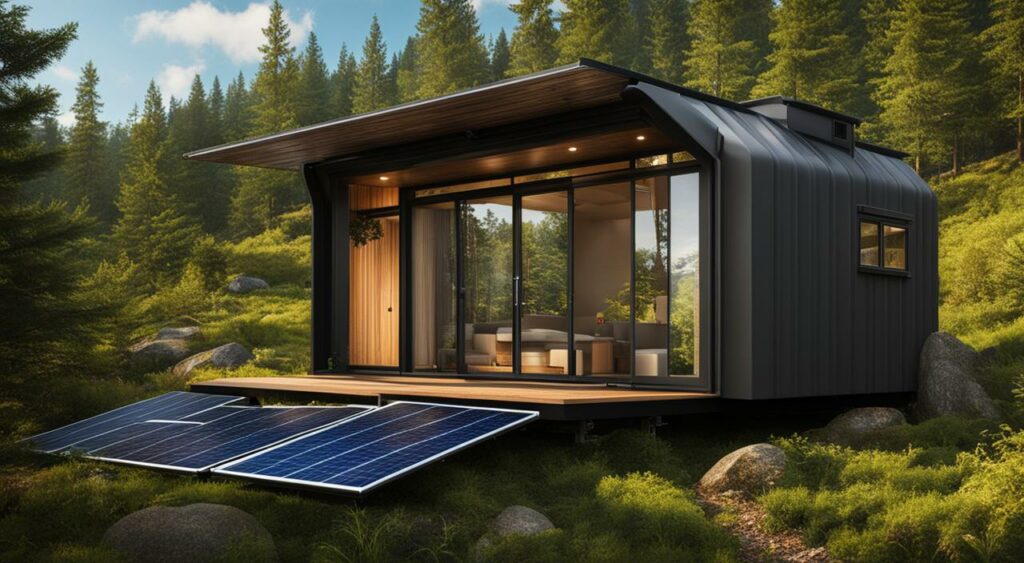
When it comes to tiny houses, there are various types and alternative housing options to choose from, ranging from mobile homes to container homes. Each option has its unique features and benefits, catering to different needs and preferences.
Portable Homes
Portable homes are a popular option for those who desire a home that can be easily transported from one location to another. These homes are designed to be mobile, and some models are built on wheels for easy towing.
They come in a range of sizes and styles, from compact models suitable for one or two occupants to larger designs that can accommodate a family.
Mobile Homes
Mobile homes are a type of prefabricated housing that are designed to be transported to a specific location. They are typically built in a factory and transported to their final destination, where they are assembled on-site.
Mobile homes can be an affordable housing option, and they come in a range of sizes and styles to suit different needs and preferences.
Park Models
Park models are a type of recreational vehicle (RV) that are designed to look like small cottages or cabins.
They are typically less than 400 square feet and are designed to be placed in RV parks or other designated park model communities.
These homes can be an excellent option for those who want to downsize or have a vacation home.
Container Homes
Container homes have become increasingly popular in recent years. These homes are made from shipping containers and are a sustainable housing option.
They are cost-effective and can be customized to suit individual needs and preferences. Container homes can be designed to be mobile or permanent, and they come in a range of sizes and styles.
Garden Offices
Garden offices are a unique alternative housing option that are designed to be used as a workspace or additional living space.
These homes are typically smaller than traditional houses and are built in a garden or backyard. They can be an excellent option for those who work from home or want a space for hobbies and leisure activities.
Overall, there are various types of tiny houses and alternative housing options to choose from, each with its unique set of features and benefits.
Whether you are looking for a mobile home or a garden office, there is an option that can suit your needs and preferences.
Planning Permission and Building Regulations for Tiny Houses

Before building a tiny house in the United Kingdom, it is crucial to understand the planning permission process and building regulations.
Tiny homes are typically considered as non-permanent structures, making it challenging to obtain planning permission. However, that doesn’t mean it’s impossible.
Permitted development rights allow for certain development without the need for planning permission. These rights may differ depending on the location, size, and intended use of the tiny house.
It is essential to check the local zoning laws to ensure compliance with the permitted development rights. Building regulations are minimum standards for safety, health, and accessibility requirements for buildings.
They primarily focus on the structural stability, fire safety, energy efficiency, and ventilation of the building.
In most cases, tiny houses on wheels are classified as caravans, which must meet specific requirements under the Caravan Sites and Control of Development Act 1960.
Permitted Development Rights for Tiny Houses
Permitted development rights allow for the construction of specified development without requiring planning permission. However, these rights are subject to certain limitations and conditions.
For instance, tiny houses built for leisure and recreational use are considered as caravans and must comply with the Caravan Sites and Control of Development Act 1960.
Meanwhile, tiny houses used for permanent dwellings may require planning permission but might qualify for permitted development under Class M of the General Permitted Development Order.
Class M of the General Permitted Development Order allows the conversion of an existing building or a new detached building within the curtilage of a house to a maximum floor space of 50 square meters.
However, there are specific limitations and conditions, such as the requirement for the building to be located within the curtilage of an existing house and for the development not to exceed the height of the existing dwelling.
Change of Use and Building Regulations
If a tiny house is intended for permanent dwelling, a change of use application might be required. Therefore, it is essential to consult with the local council to obtain the necessary planning permission and building regulations approvals.
Building regulations apply to both permanent and non-permanent structures.
However, tiny houses on wheels are classified as caravans and must meet the specific requirements under the Caravan Sites and Control of Development Act 1960.
It is worth noting that meeting building regulations is mandatory, and failure to comply may result in legal action.
Therefore, it is essential to work with a building professional who has experience in designing and constructing tiny houses that comply with building regulations.
“It is essential to consult with the local council to obtain the necessary permissions and approvals. Meeting building regulations is mandatory, and failure to comply may result in legal action.”
Zoning Laws and Restrictions for Tiny Houses in the UK
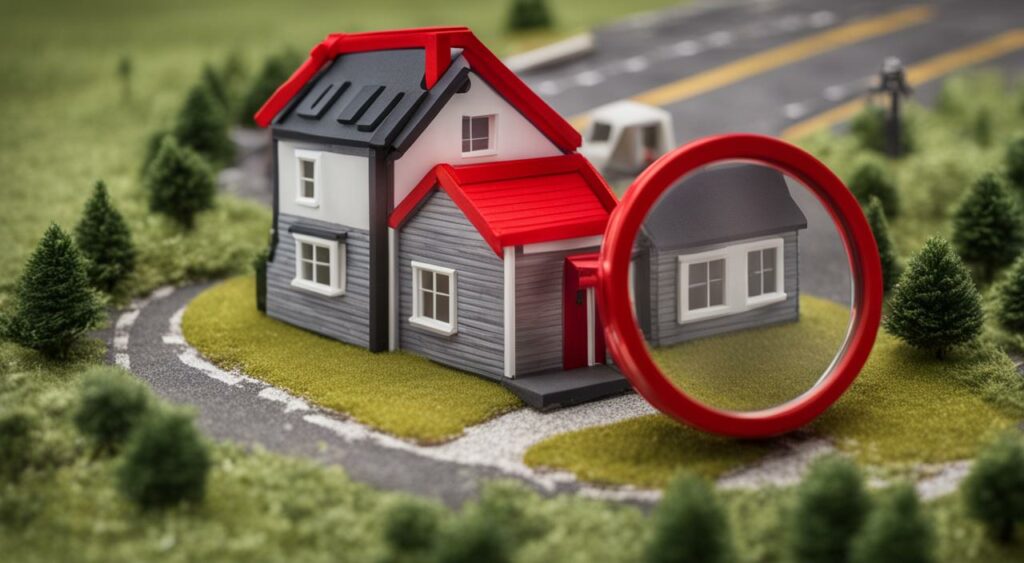
Tiny houses are an alternative form of sustainable and affordable housing that is gaining popularity across the UK.
However, building a tiny home requires careful planning, adherence to building codes, and compliance with zoning laws and land use restrictions.
Zoning laws are key legal regulations that govern how land is used and developed within a particular area.
Understanding zoning laws is critical to ensuring that your tiny house is built on legal land and will not be subject to legal challenges or removal orders.
Zoning laws in the UK are complex and can vary significantly between different regions.
The laws may restrict the minimum size of a dwelling unit, dictate the placement of tiny houses on specific types of land, or prohibit certain types of tiny homes altogether.
Local councils are responsible for enforcing zoning laws and may issue fines or removal orders to violators.
It is essential to research and understand the zoning laws in your area before embarking on a tiny house project.
In some cases, seeking legal counsel from a solicitor may be advisable to navigate complex zoning regulations. Some of the key zoning laws and restrictions that apply to tiny houses in the UK include:
| Land Use Restrictions | Permitted Size of Tiny Houses | Considerations for Stand-alone Dwellings on Private Land |
|---|---|---|
|
Land use restrictions are zoning laws that dictate the type of activities that are allowed on specific types of land. Tiny houses may fall under different land use categories, such as residential, agricultural, or commercial. Some regions may also have zoning laws that restrict the use of tiny homes in urban areas or require them to be located on specific types of land. |
Zoning laws may place restrictions on the size of a dwelling unit, including tiny houses. For example, some regions may have minimum size requirements for a residential unit, which may exceed the size of a typical tiny house. Compliance with size restrictions may be a critical factor in securing permits and ensuring that your tiny house is legal. |
If you plan to build a tiny house on your private land, you must ensure that it complies with all applicable zoning laws and building regulations. In some areas, standalone dwellings may require additional permits or inspections, such as septic system or environmental impact assessments. |
Adherence to zoning laws and restrictions is critical to ensuring the long-term viability of a tiny house project. Violating zoning laws can result in significant legal challenges and financial penalties.
Therefore, researching and understanding the zoning laws and regulations in your region is essential to avoid legal complications and ensure a successful journey into tiny house living.
Financial Considerations and Affordable Housing
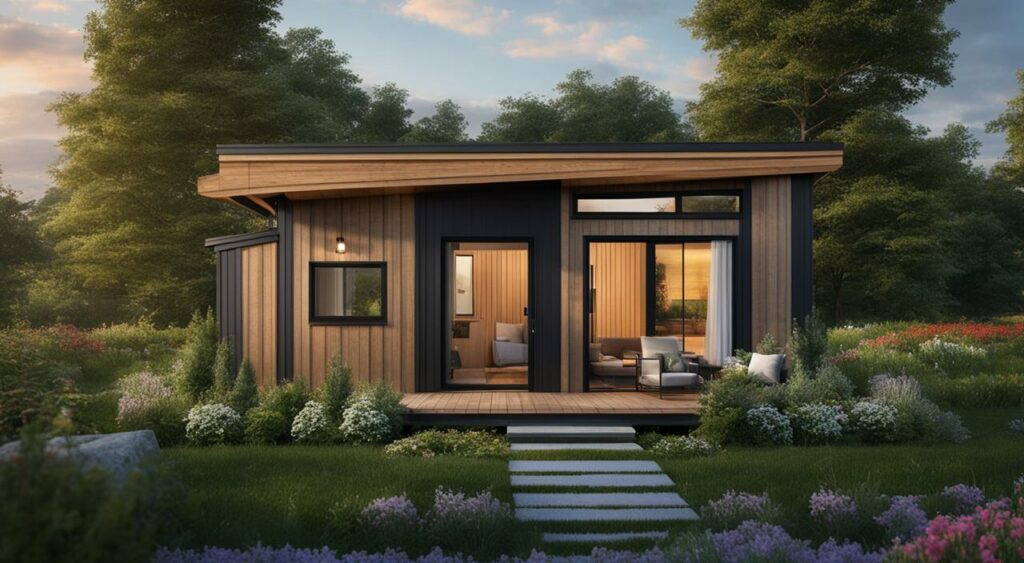
In light of the UK’s housing affordability crisis, more people are turning to tiny house living as a solution to achieve financial freedom.
Tiny houses are significantly cheaper to build and maintain than traditional homes, making them an affordable housing option for many.
According to a study by the Tiny House Society, the average cost to build a tiny house is around $23,000, whereas the average cost of a traditional house in the UK is over $300,000.
This makes tiny houses an attractive option for those looking to own their own home without incurring significant debt.
Achieving Financial Freedom
Tiny houses offer individuals the opportunity to live debt-free or mortgage-free, providing them with financial freedom.
With a smaller living space, maintenance and utility costs are significantly lower than those of traditional homes.
“The freedom to do what you want without money worries is priceless”
-Tiny House UK
Furthermore, those who opt for tiny house living often downsize their possessions, allowing them to save money on items they no longer require.
A minimalist lifestyle can lead to reductions in both physical and financial clutter, promoting a more efficient and cost-effective way of living.
A Solution to the Housing Affordability Crisis
The UK is currently facing a housing affordability crisis, with many individuals struggling to find homes they can afford.
Tiny houses offer a viable solution to this problem, as they are an affordable and sustainable housing option that can be built on a smaller budget.
Moreover, tiny houses are often built on wheels or can be easily transported, providing individuals with flexibility in terms of location and reducing the reliance on expensive land purchases.
This makes tiny houses an attractive option for those who cannot afford to purchase traditional homes or who wish to lead a more mobile lifestyle.
Tiny House Living and Sustainable Housing
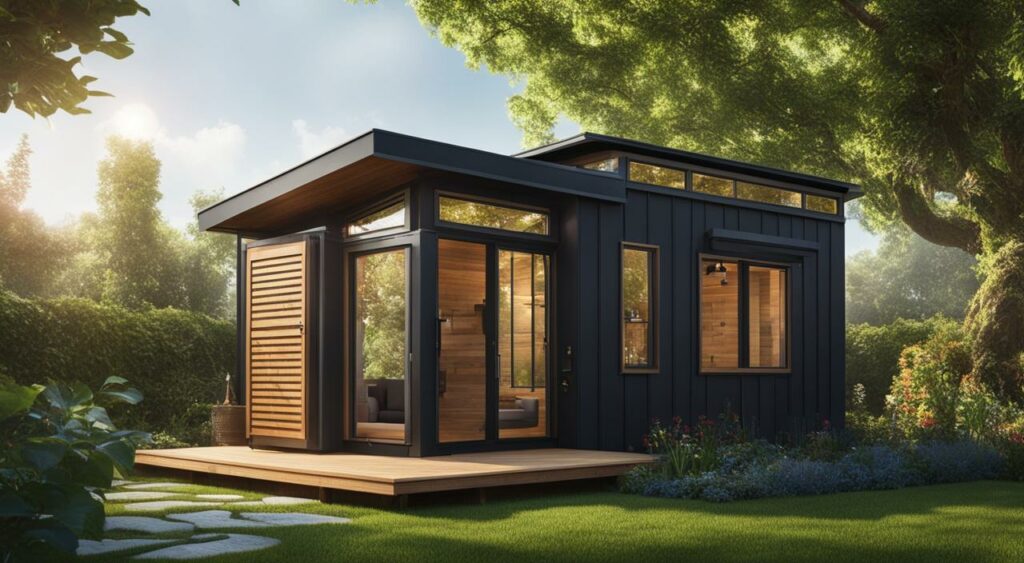
Sustainable living has become a major concern in recent years, and tiny house living aligns with eco-friendly and green practices.
By downsizing their living space, tiny house dwellers often use fewer resources and generate less waste compared to traditional homeowners.
In addition, many tiny houses are built with sustainable materials, such as reclaimed wood or recycled steel, further reducing the environmental impact.
Another aspect of eco living in tiny houses is their energy efficiency.
Many tiny houses incorporate solar panels, composting toilets, and rainwater harvesting systems, reducing reliance on non-renewable resources and lowering utility bills.
The benefits of sustainable housing options extend beyond environmental concerns.
By living in a tiny house, individuals can experience financial freedom and save money on utility bills, making housing more affordable.
Additionally, downsizing can simplify life, reducing stress and increasing well-being.
“Living in a tiny house has been the best decision I’ve ever made. I feel more connected to nature and less focused on material possessions. It’s given me a new perspective on what’s truly important in life.” – Tiny house owner
Green Design in Tiny Houses
Green design principles are often incorporated into the construction of tiny houses. This includes not only the use of sustainable materials but also the design of the living space to maximize energy efficiency.
For example, many tiny houses feature large windows to allow for natural light and passive solar heating. The use of high-efficiency appliances and LED lighting can also reduce energy consumption.
In addition, tiny houses often incorporate space-saving design features, such as multi-functional furniture and storage solutions, which can reduce the need for additional resources and materials.
Community Sustainability
Tiny houses can also promote sustainable living on a community level.
By clustering small dwellings together, tiny house communities can share resources and reduce overall energy consumption.
Community gardens and composting areas can provide opportunities for sustainable food production and waste reduction.
| Sustainable Living Benefits | Community Sustainability Benefits |
|---|---|
| – Lower environmental impact | – Shared resources |
| – Energy efficiency | – Reduced energy consumption |
| – Financial freedom | – Sustainable food production |
| – Simplified living | – Waste reduction |
By choosing sustainable living options, tiny house dwellers contribute to a healthier environment while also simplifying their own lives.
Legal Requirements and Regulations for Tiny Houses in the UK
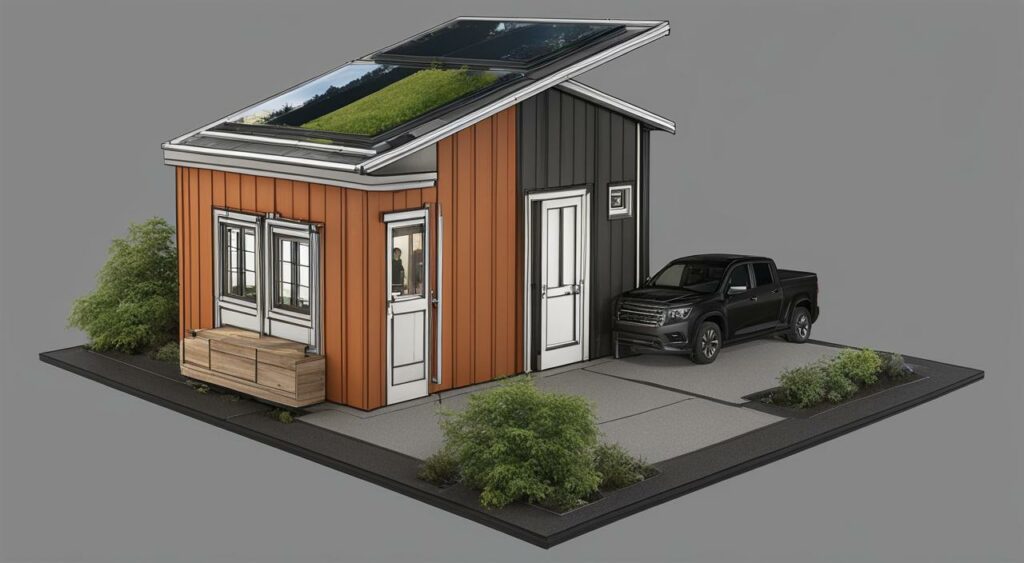
Living in a tiny house can be an attractive option for those looking to downsize, live debt-free, or reduce their environmental impact.
However, before embarking on this lifestyle, it is essential to understand the legal requirements and regulations that apply to tiny houses in the United Kingdom.
A tiny house, unlike a standard home, may not meet the minimum size requirements set by local councils for permanent dwellings.
There is no specific legislation that governs the building of tiny houses in the UK.
Therefore, they are typically subject to planning permission and building regulations that apply to other types of dwellings.
The building codes require all structures to meet specific safety and structural standards. Thus, it is vital to ensure that your tiny house meets those requirements before occupying it.
Additionally, the government has established a framework of guidelines known as “Permitted Development Rights,” which allow some flexibility in building tiny houses.
For instance, a tiny house on wheels may qualify as a caravan, which requires fewer planning permissions and building regulations.
Planning Permission
Planning permission refers to the process of obtaining permission from your local council.
The purpose of the process is to ensure that your planned building work complies with the local zoning regulations and building codes.
Applications for planning permission can be submitted online or in person, and the process usually takes between 8-12 weeks.
If you are building your tiny house on a piece of land, it must have a residential status or an established usage right.
Applications for change of use must be submitted to the local council and require adequate documentation, including a land survey and detailed building plans.
The government’s document, “Planning Portal,” provides comprehensive information on the planning permission process.
It is essential to refer to this guideline to ensure your tiny house complies with the local council’s requirements.
Building Regulations
Building regulations are the minimum standards for design, construction, and alteration of buildings in the UK. The regulations are set out to ensure the safety and health of the occupants of the building and its visitors.
The building codes require all structures, including tiny houses, to meet specific safety and structural standards.
The United Kingdom government has established a document known as “Approved Documents,” which provide guidance on how to meet the building regulations.
The documents cover several aspects of building construction, including fire safety, energy efficiency, and structural integrity.
It’s essential to note that a tiny house on wheels may qualify as a caravan.
Caravans are classified under the Caravan Sites and Control of Development Act 1960 and require fewer building regulations.
Tiny House Legislation
Currently, there is no specific legislation governing the building and occupancy of tiny houses in the UK.
The tiny house movement is still relatively new, and existing legislation is yet to catch up with these alternative housing options.
However, the government has released documents such as “Permitted Development Rights” and “Approved Documents” that tiny house builders and occupants can use as a guideline.
It is also important to note that regulations vary by local council. Therefore, it is important to check with your local council regarding the zoning laws, building regulations, and permits required in your area.
Tiny House on Wheels and Road Legality

For those interested in mobility with their tiny homes, tiny houses on wheels (THOW) are a popular option. However, it is important to understand the legality of using these homes on public roads in the UK.
In general, tiny houses on wheels are treated similarly to caravans for road legality purposes. As long as they meet certain requirements, tiny homes on wheels can be legally towed on UK roads.
According to the Caravan and Motorhome Club, the maximum width for a THOW is 2.55 meters, and the maximum length is 7 meters (not including a permissible 1.3-meter drawbar).
Additionally, the maximum height for a THOW is 4.3 meters.
It is important to note that the driver must hold a valid driver’s license and ensure that the vehicle and tow combination do not exceed the legal weight limit for the road.
Failure to comply with these requirements may result in fines or other legal consequences.
Caravan Category
Tiny houses on wheels are typically categorized as “caravans” for road legality purposes. However, they must meet certain requirements to be classified as such.
For example, the vehicle must have adequate bathroom and cooking facilities, as well as a sleeping area. It must also be designed for transportation on public roads and not permanently installed on a site.
If the tiny home on wheels does not meet these requirements, it may be categorized as an abnormal load or other vehicle category, resulting in additional legal requirements and restrictions.
Caravan Sites and Regulations
When it comes to parking and using tiny houses on wheels, it is essential to follow the regulations for caravan sites.
These sites may require specific permits or fees, and there may be restrictions on the length of stay or the number of vehicles allowed per site.
Additionally, some local councils have specific regulations related to parking and using tiny homes on wheels as dwellings, particularly on private land.
It is crucial to research and understand these regulations before attempting to park or use a THOW.
“Tiny houses on wheels are typically categorized as ‘caravans’ for road legality purposes.”
Regional Differences and Case Studies
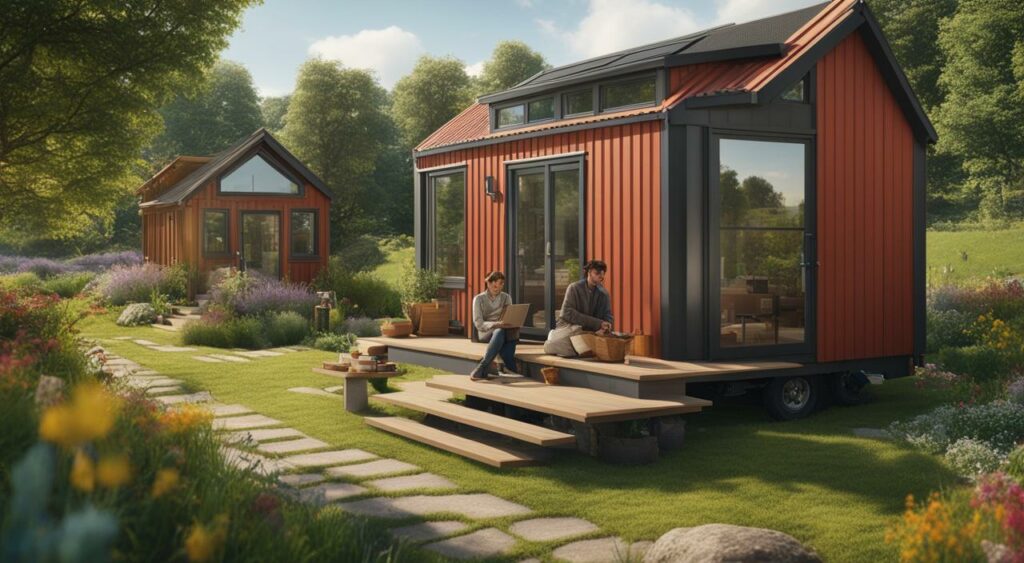
The UK has varying regulations when it comes to tiny house living. For example, Bristol City Council has been quite supportive of the movement and has allowed people to live in tiny houses as long as they have a permitted development.
On the other hand, the Cornwall Council has recently voted against a proposed plan to build tiny houses on land designated for agricultural use.
Truro has become a popular destination for tiny house enthusiasts due to its lax zoning laws. In fact, in a recent article by CornwallLive, a couple shared their experience of building and living in a tiny house in Truro.
They were able to complete the entire project under 15,000 pounds, which is significantly cheaper than traditional housing options.
To showcase the regional differences in tiny house regulations, the table below summarizes some of the key variations:
| Region | Tiny House Regulations |
|---|---|
| Bristol | Permitted development for tiny houses on wheels and permanent foundations. |
| Truro | Lax zoning laws allow for stand-alone tiny houses on private land. |
| Cornwall Council | Recently voted against a proposed plan to build tiny houses on land designated for agricultural use. |
It is clear that regulations vary significantly across different regions in the UK. As more people choose to embrace tiny house living, it will be interesting to see how the regulations evolve over time.
Advocacy Groups and Future of Tiny House Living in the UK
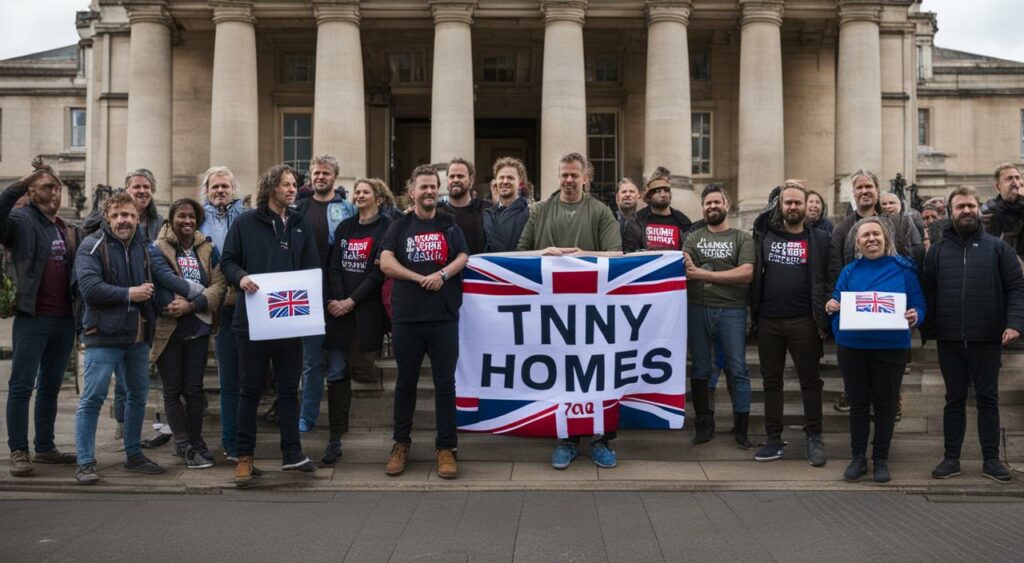
As the tiny house movement gains momentum in the UK, there has been an increase in advocacy groups working to promote and support this alternative housing option.
These groups offer a platform for tiny house enthusiasts to connect, share resources, and advocate for more favorable legislation.
Small is Beautiful is an example of a UK-based advocacy group that aims to promote sustainable living and eco-consciousness through tiny house living.
The group offers workshops, meetups, and resources for individuals interested in downsizing and achieving financial freedom through tiny house living.
Another notable group is the United Tiny House Association, which organizes tiny house festivals and events across the US and Canada.
Although based in the US, the group has a growing presence in the UK and is committed to advocating for tiny house-friendly legislation worldwide.
As these advocacy groups continue to spread awareness and promote the benefits of tiny house living, it is likely that we will see more favorable legislation and government policies in the future.
However, there are still challenges that need to be addressed, such as the lack of clarity around land use restrictions and building regulations.
To ensure a bright future for tiny house living in the UK, it is essential for advocacy groups to continue their efforts in educating and pushing for change.
By working together and creating a strong voice, they can influence government policies and regulations to facilitate the growth of tiny house communities across the country.
The Need for Legislative Change
One of the main goals of advocacy groups is to push for legislative change that supports tiny house living in the UK.
At present, the legal requirements and regulations for tiny houses are often unclear and can vary greatly depending on the region.
A recent survey conducted by the advocacy group Small is Beautiful found that many individuals interested in tiny house living are discouraged by the lack of clarity around zoning laws and building regulations.
This has led to a lot of confusion and frustration, particularly for those considering building their own tiny homes.
The survey also highlighted the need for more affordable housing options in the UK, with many individuals struggling to find affordable accommodation in the current housing market.
Tiny houses have the potential to provide a solution to this problem, but only if legislation is changed to facilitate their development and growth.
The Future of Tiny House Living in the UK
Despite the challenges, the future of tiny house living in the UK looks bright.
As more individuals become aware of the potential benefits of downsizing and minimalism, we are likely to see an increase in demand for tiny houses.
Advocacy groups will continue to play a vital role in promoting tiny house living and pushing for legislative change.
Through their efforts, we can hope to see more favorable zoning laws, building regulations, and government policies that support the growth of tiny house communities across the UK.

Conclusion
As the tiny house movement gains momentum in the UK, it is crucial for aspiring tiny house homeowners to understand the legal requirements and regulations that apply to this alternative housing option.
From the planning permission process and building regulations to zoning laws and road legality, there are a variety of legal considerations to keep in mind when embarking on a tiny house living journey.
Takeaways:
- Acquiring necessary permits and complying with building regulations is critical to ensuring a successful and legal tiny house project.
- Zoning laws and restrictions differ depending on the region and type of tiny house, which may impact where a tiny house can be located.
- Living in a tiny house can offer financial freedom and sustainability advantages, while also addressing the affordable housing crisis in the UK.
- Advocacy groups are working towards promoting tiny house living and advocating for legislative changes to better accommodate this housing option.
Overall, understanding the legal landscape of tiny houses in the UK is essential for ensuring a smooth and successful journey into this alternative housing option.
By complying with legal regulations and staying informed about potential changes and developments, tiny house enthusiasts can embrace this minimalist lifestyle and contribute to a more sustainable and affordable housing future.
Other related articles
- Tiny House Laws Indiana: Unlocking the Secrets
- Tiny House Laws in Massachusetts: The Ins and Outs
- Tiny House Laws Colorado: A Friendly Guide
- Tiny House Laws in Florida: Everything You Need to Know
- Understanding Tiny House Laws in Virginia: A Quick Guide
- Tiny House Laws Wisconsin: Understanding The Law

Arc. Joseph Benson the CEO of Free tiny homes, Free Tiny Homes is a free, open-source, collaborative resource for anyone interested in building their own tiny home…


